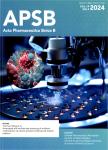Antihyperuricemic effect of mangiferin aglycon derivative J99745 by inhibiting xanthine oxidase activity and urate transporter 1 expression in mice
Antihyperuricemic effect of mangiferin aglycon derivative J99745 by inhibiting xanthine oxidase activity and urate transporter 1 expression in mice作者机构:Beijing Key Laboratory of Drug Target and Screening Research Department of New Drug R&D Institute of Materia Medica Chinese Academy of Medical Science and Peking Union Medical College
出 版 物:《Acta Pharmaceutica Sinica B》 (药学学报(英文版))
年 卷 期:2018年第8卷第2期
页 面:306-315页
核心收录:
学科分类:1008[医学-中药学(可授医学、理学学位)] 1006[医学-中西医结合] 100602[医学-中西医结合临床] 10[医学]
基 金:supported by National Natural Science Foundation of China(81573645,81202538 and 81673422) CAMS Innovation Fund for Medical Sciences(CIFMS,2016-I2M-3-007) National Science and Technology Major Projects for "Major New Drugs Innovation and Development"(2013ZX09508104and 2013ZX09402203)
主 题:Antihyperuricemic effect Mangiferin aglycon Derivative Xanthine oxidase Urate transporter 1
摘 要:A mangiferin aglycon derivative J99745 has been identified as a potent xanthine oxidase(XOD) inhibitor by previous in vitro study. This study aimed to evaluate the hypouricemic effects of J99745 in experimental hyperuricemia mice, and explore the underlying mechanisms. Mice were orally administered 600 mg/kg xanthine once daily for 7 days and intraperitoneally injected 250 mg/kg oxonic acid on the 7 th day to induce hyperuricemia. Meanwhile, J99745(3, 10, and 30 mg/kg), allopurinol(20 mg/kg) or benzbromarone(20 mg/kg) were orally administered to mice for 7 days. On the 7 th day,uric acid and creatinine in serum and urine, blood urea nitrogen(BUN), malondialdehyde(MDA) content and XOD activities in serum and liver were determined. Morphological changes in kidney were observed using hematoxylin and eosin(H&E) staining. Hepatic XOD, renal urate transporter 1(URAT1), glucose transporter type 9(GLUT9), organic anion transporter 1(OAT1) and ATP-binding cassette transporter G2(ABCG2) were detected by Western blot and real time polymerase chain reaction(PCR). The results showed that J99745 at doses of 10 and 30 mg/kg significantly reduced serum urate, and enhanced fractional excretion of uric acid(FEUA). H&E staining confirmed that J99745 provided greater nephroprotective effects than allopurinol and benzbromarone. Moreover, serum and hepatic XOD activities and renal URAT1 expression declined in J99745-treated hyperuricemia mice. In consistence with the ability to inhibit XOD, J99745 lowered serum MDA content in hyperuricemia mice. Our resultssuggest that J99745 exerts urate-lowering effect by inhibiting XOD activity and URAT1 expression, thus representing a promising candidate as an anti-hyperuricemia agent.



